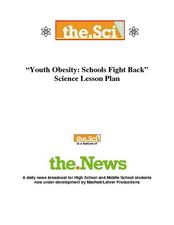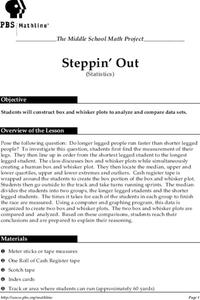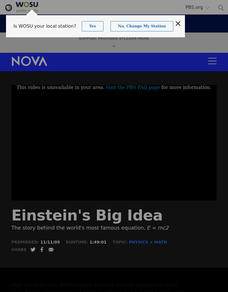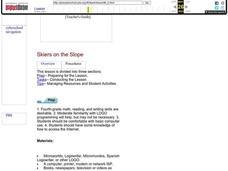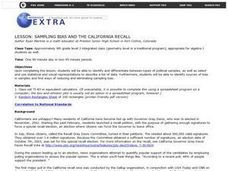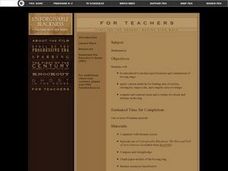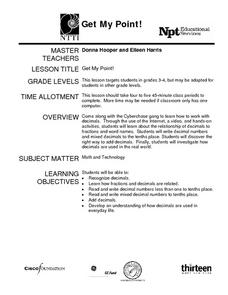Curated OER
Youth Obesity: Schools Fight Back
Explore nutrition and healthy eating habits with a study on youth obesity. Learners watch a PBS documentary on the obesity epidemic which discusses government programs aimed at healthier choices, as well as more localized efforts. Kids...
Curated OER
Steppin' Out
Students are presented with the question: "Do longer legged people run faster than shorter legged people?" Students conduct an experiment, collect their data, create box and whisker plots using a computer and graphing program, and...
Curated OER
The Robot Artist--Aaron
This is a creative multidisciplinary lesson which will involve learners in art, technology, and psychology. Students learn about Harold Cohen who created a robot programmed to create art. Learners will also enjoy the sand pendulum...
Curated OER
Fractions and Decimals and Percents; Oh, My!
Fourth graders watch a PBS video about fractions, percents and decimals. They fill in fraction circles and rename them in decimals and percents. They visit and interact on a fractions, decimals and percents website and solve problems.
Curated OER
NOVA Online/Einstein Revealed
Welcome to the companion Web site to the NOVA program "Einstein Revealed," originally broadcast in October, 1996. This two-hour special presents a penetrating profile of Albert Einstein, who contributed more than any other scientist to...
Curated OER
Skiers on the Slope
Students explore mathematical concepts, problem solving, and the ability to program in LOGO to test ideas about speed, acceleration, gravity, and slope when dealing with downhill skiing.
Curated OER
Form an Opinion-Cats
Students discuss which animal makes a better pet. In this statistics lesson, students examine the factors that cause people to choose one animal over the other (cat or dog). Students discuss their own opinions, and then view...
Curated OER
Sampling Bias And the California Recall
Using a 2002 California Gray David recall vote as an example, young statisticians identify sources of bias in samples and find ways of reducing and eliminating sampling bias. They consider ways to select random samples from a...
PBS
The History and Use of Sampling Methods
Young mathematicians define population, draw convenience sample from the population, draw quota sample from the population, and draw random probability sample from the population. They explain why a random probability sample usually...
Curated OER
Circling the Square: Boxing Ring Match
Young scholars analyze the specifications and construction of modern boxing rings. They calculate the area of circles and rectangles by different methods. They compare and contrast different areas in the ring used for attack and defense.
Curated OER
Studying Birds in the Field
This is a well-designed science activity which helps learners learn the behavior of different species of birds. Working with partners and in small team, students learn to scientifically observe birds.
Curated OER
World in the Balance
Students make estimates on how many people they believe live on Earth. While watching a video, they take notes on the issues facing Kenya, Japan and India. In groups, they calculate how long it takes for a country to double in size. To...
Curated OER
Making Healthy Food Choices
In this well-designed nutritional activity, students are given the opportunity to create their own daily food record, compare their nutrient with minimimun requirements, and think critically about their own food choices. Materials and...
Curated OER
Special Effects-Titanic and Beyond
Students view a video clip about special effects. They use geometry to determine how it changes one's perspective. They work together to construct their own room and comparing their room with other groups, noting the type of...
Curated OER
SOS: Save Our Ski Slopes
Students defend downhill skiing as an Olympic Games event by creating a presentation that graphically proves the economic impact and popularity of this event.
Curated OER
Divers's Decompression
Students are exposed to the physics and physiology of scuba diving, study the principals applied in the U.S. Navy Decompression tables and work out typical decompression problems.
Curated OER
Geodesic Dome
Students build geodesic domes using newspaper after watching a video about the architectural concepts used in building domes. They decide which geometric shapes can be used to build the strongest building.
Curated OER
Get My Point!
Here is one of the better lessons I've come across on how to teach fractions and decimals. This instructional activity does a great job of showing how these two mathematical representations of numbers are interrelated. Some excellent...
Curated OER
City, County, Community
Students explore issues and situations that make for a city and its local environments. In this local government lesson, students design maps, define issues and create brochures that illustrate their understandings of these concepts and...
NTTI
I'll Halve S'more Please!
There is a lot to learn about fractions, and this is a fun way to do it! Individuals participate in a Cyberchase activity to describe a fraction in terms of sharing parts of a whole. They determine the meaning of the parts of a fraction,...
Curated OER
Budget Making
Learners develop a budget for spending and saving. In this economics lesson plan, students create a budget based on personal, family and government income. They discuss jobs at home and allowances. They discuss how they manage their...
Curated OER
Introduction to the National Debt
Students relate the national debt to the economy. In this algebra instructional activity, students discuss what the national debt is, create a national budget based on priority and what the government should spend money on. They analyze...
Curated OER
Tessel Your Way to Nagano!: Olympics, Winter Sports, Snowboarding, Graphic Design, Geometry, Math, M.C. Escher, Tessellations
Students create Post-It note fundamental regions to tesselate. They make tesselations using computer software or websites. They create a jacket design with tesselation and determine the cost of production.
Curated OER
Slopes, Hopes, & Speed
Students investigate the sport of skiing through Internet research in this multi-task lesson. They compare and generalize the results of five individuals by using mean, median, and mode.
